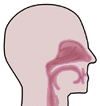  |
||
 |
January 2005 Antiapoptotic Mechanism Action of Theophylline in Restoring Smell Function Theophylline treatment restores smell function in some patients with smell loss (hyposmia). Theophylline is a phosphodiesterase (PDE) inhibitor. As such it inhibits the breakdown of cAMP thereby increasing whatever amount of cAMP is made. cAMP normally acts as a growth factor stimulating stem cell maturation in the olfactory epithelium — this stimulation causes stem cells to generate all cells in the olfactory epithelium which are necessary to maintain normal olfaction. Thus, the less cAMP, the less smell; the more cAMP, the more smell. This has been the mechanism by which we have considered theophylline to work in order to restore smell function among hyposmic patients. However, we know that theophylline has a multiplicity of functions in addition to its action as a PDE inhibitor. In an effort to evaluate these other functions we carried out a series of experiments to evaluate these other functions. It is well known that there is a metabolic balance between cell growth and cell death. All stem cells in the body depend upon specific growth factors to stimulate their growth and maturation so that they can produce the functionally active cells necessary to maintain the function of the specific system which they represent. But all cells must also die and they also do so in a very specific manner. One form of cell death is called programmed cell death or APOPTOSIS. This process affects all cells and is controlled by several complex reactions which monitor and signal when and how long cells should survive. These reactions can be considered “death reactions” and the substances that do this can be considered “death factors”. These “death factors” can be found in nasal mucus as well as in other body fluids. If we did not have such reactions for cell death and cells did not die, all of our cells would live forever and we would all be bigger than elephants. The complex signals which control APOPTOSIS involve a multiplicity of chemical moieties: these moieties act both to initiate cell growth and cell death and they also report on whether cells have indeed died. One system, and there are many, involved in this complex of “death factors” involves tumor necrosis factor α (TNF α) and two sets of soluble receptors of this system, TNF α receptor1 (TNF α R1) and TNF α R2. If these apoptotic substances are increased in any biological fluid then we know that there is increased apoptosis and that cells are dying more rapidly than normal- this is called abnormal apoptosis or increased cell death. Nasal mucus is the biological fluid which bathes the olfactory epithelial cells, and as noted above, it contains the substances which cause cells to grow and to die and to signal that cell growth or cell death is occurring. We measured TNF α, TNFR1 and TNFR2 in nasal mucus in patients with hyposmia before any treatment for their smell loss and after treatment with theophylline. Before treatment with theophylline TNF α, TNF α R1 and TNF α R2 levels in nasal mucus were significantly INCREASED above those found in normal subjects. This indicates that the cells in their olfactory epithelium were dying more rapidly than normal. However, after theophylline treatment we found levels of each of these substances to be significantly DECREASED, between 50-80%, and associated with INCREASED SMELL FUNCTION. As the dose of theophylline increased from 200mg to 400mg to 600mg there was a dose dependent decrease in TNFα and TNFα R1 and TNFα R2 and a dose dependent increase in smell function. These results indicate that the “death factors” in nasal mucus decreased after theophylline treatment and indicate that cells in the olfactory epithelium were functioning in a more normal manner. These results are (1) the first to demonstrate specific biochemical changes associated with theophylline treatment and (2) suggest that the antiapoptotic action of theophylline reverses one part of the pathology associated with inhibition of smell function in patients with hyposmia. These results will be presented at the April 2005 meeting of the American Federation for Medical Research to be held in Washington DC and will be published in the Journal of Investigative Medicine in 2005. Home
| The Clinic | Diagnosis
| Treatment | FAQ
| Press |
|